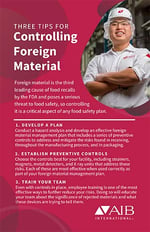3 Tips for Foreign Material Control
Food safety isn’t just threatened by pathogens: Foreign materials (non-food substances) like metal shavings, glass fragments, or even insects can fall into or become embedded in products at any point in the production process. If any of these substances reach consumers, they can create a serious risk of choking, injury, or other type of contamination to consumers.

Foreign material in food is one of the leading causes of FDA recalls and poses a serious threat to food safety. Implementing a foreign material control program is a critical aspect of any food safety plan and must be prioritized alongside cleanliness and sanitation.
What are the most common types of foreign material in foods?
As a category, ‘foreign material’ accounts for any type of non-food object that contaminates a food or beverage product. The most common physical contaminants are:
- Plastic fragments from packaging materials or broken parts of processing equipment
- Metal shards from broken machinery
- Glass pieces from bottles, jars, or light fixtures
- Wood splinters from wooden pallets and crates
- Stones, rocks and insects from farms
- Hair and fibers from human workers
3 Tips for Foreign Material Control
Any of these foreign materials can cause serious bodily harm to consumers, as both cut and choking hazards — or worse. Implementing an effective foreign material control program is critical to avoiding a recall and preventing injury. Here are three tips to help:
1. Develop a foreign material management plan
Each manufacturing facility’s risks will be different and warrant a different series of controls. To better understand the risks specific to your facility, your food safety team can conduct a hazard analysis, which will help them discover how foreign materials may get into your products. Based on this assessment, you can develop an effective foreign material management plan that includes a series of preventive controls to address and mitigate the risks found in receiving, throughout the manufacturing process, and in packaging.
2. Establish preventive controls
To assist in detecting foreign material, there are a variety of systems that can be used, including strainers, magnets, metal detectors, and X-ray units. Choosing the controls that are best for your facility should be based upon the hazard analysis you’ve conducted, which will provide an understanding of the risks faced, and direct implementation of the necessary detection systems. Examples of possible controls include:
- Metal detectors are among the most used, as they help ensure that contaminated finished products do not reach consumers. Metal detectors are also used to protect manufacturing equipment by detecting foreign material that could cause equipment damage.
- Strainers are typically for screening bulk liquids during receipt and as the final monitoring step for foreign material control in liquids manufacture. The strainer’s ability to screen material is impacted largely by the viscosity of the materials being received and the flow rate needed to offload the material. When producing liquid products, the filtration provided by the strainer is often more sensitive than what can be provided by metal detection equipment.
- Magnets are highly effective in screening out ferrous metals that may damage equipment, particularly as part of unloading of raw agricultural commodities. They will also help protect equipment in areas where there are moving parts that could be damaged by foreign material.
- X-ray units are generally used when the type of packaging used for finished products interferes with screening of finished products for foreign materials. Manufacturers that package in foil, such as pies in aluminum tins, use these devices. X-ray machines can be set to detect materials despite the metal composition of the packaging materials. They are also effective in identification of non-metallic foreign materials, such as fruit pits.
Each of these systems is then most effective when used correctly as part of a foreign material management plan and overseen by a trained team.
3. Train your team
Despite the use of foreign material removal devices in food processing, employee training is one of the most effective ways to take control of this highly visible and potentially damaging issue. By supporting employees with training to identify possible sources of foreign material and improve their controls, you will further reduce your risks. For instance, even the best metal detectors can be bypassed by an employee who places rejected product back on the line or turns off the metal detector or reject device when numerous rejects occur. The most important aspect of a foreign material detection policy is to educate employees about the significance of rejected materials and what the device is trying to tell them.
Master Foreign Material Control With AIB International
Developing and implementing an effective foreign materials control program, executed by a well-trained team, will minimize your risk of food contamination and maximize food safety and quality. Leveraging third-party expertise to identify potential hazards or train your employees for better foreign material control are both important investments to avoid food safety breaches.
AIB International has helped food and beverage companies across the globe manage foreign material control programs for over 100 years. For all manufacturers, we offer a Foreign Material Control Assessment that helps identify gaps in written programs, evaluate employee practices, and assess plant and equipment conditions, resulting in actionable recommendations that work for your specific facility. We also offer an online course for training employees about Foreign Material Management that is specifically developed for snack and baked goods manufacturers and the specific scenarios those operations face.


